If you’re like most ecommerce marketers, you’re always looking for new ways to boost your website traffic, grow your email list, and sell more products.
However, for new marketing strategies to be effective, you first need to understand how potential customers behave online, as well as what they need and value most.
To help you with that, I’ve put together 19 of the most important ecommerce statistics every marketer needs to know, together with their key takeaways.
Use these new studies to inform your 2023 marketing strategy, and apply these concrete takeaways to help grow your business.

Ecommerce Statistics You Can't Miss:
- 2.14 Billion Online Shoppers Worldwide
- Only 2.17 Percent of Ecommerce Visits Convert
- Ecommerce Accounts for 18 Percent of All Sales
- Amazon Will Account for 50 Percent of All Retail Sales in 2021
- E-Retail Sales Will Grow to $5.4 Trillion in 2022
- 61 Percent of Online Retail Traffic Comes from Mobile
- 68 Percent of Shoppers Google a Product Before Purchasing
- Fashion Shoppers View 32 Pages Before Making a Purchase
- Shoppers Value In-Stock Availability and Fast Delivery Most
- 3D Product Images Increase Conversions by 250 Percent
- Digital/Mobile Wallets Account For 45 Percent of Ecommerce Payments
- Popups in Ecommerce Convert at 4.76 Percent on Average
- Popups With Two Input Fields Outperform All Others
- Mobile Popups Convert at 5.8 Percent on Average
- The Average Cart Abandonment Rate Is 69.80%
- 49 Percent of Shoppers Abandon Their Carts Due to Unexpected Extra Costs
- Abandoned Cart Emails Have an Average Open Rate of 45 Percent
- Three-Quarters of Repeat Purchases Are Made Online
- The Fastest-Growing Ecommerce Niches of 2020 Are Disposable Gloves and Bread Machines
1. Ecommerce Statistic #1: There Are 2.14 Billion Online Shoppers Worldwide
Online shopping is getting bigger each year.
With the Covid19 pandemic, more consumers are going online to buy everything from groceries to luxury items.
As a result, Statista estimates that there will be 2.14 billion global buyers online by the end of 2021.
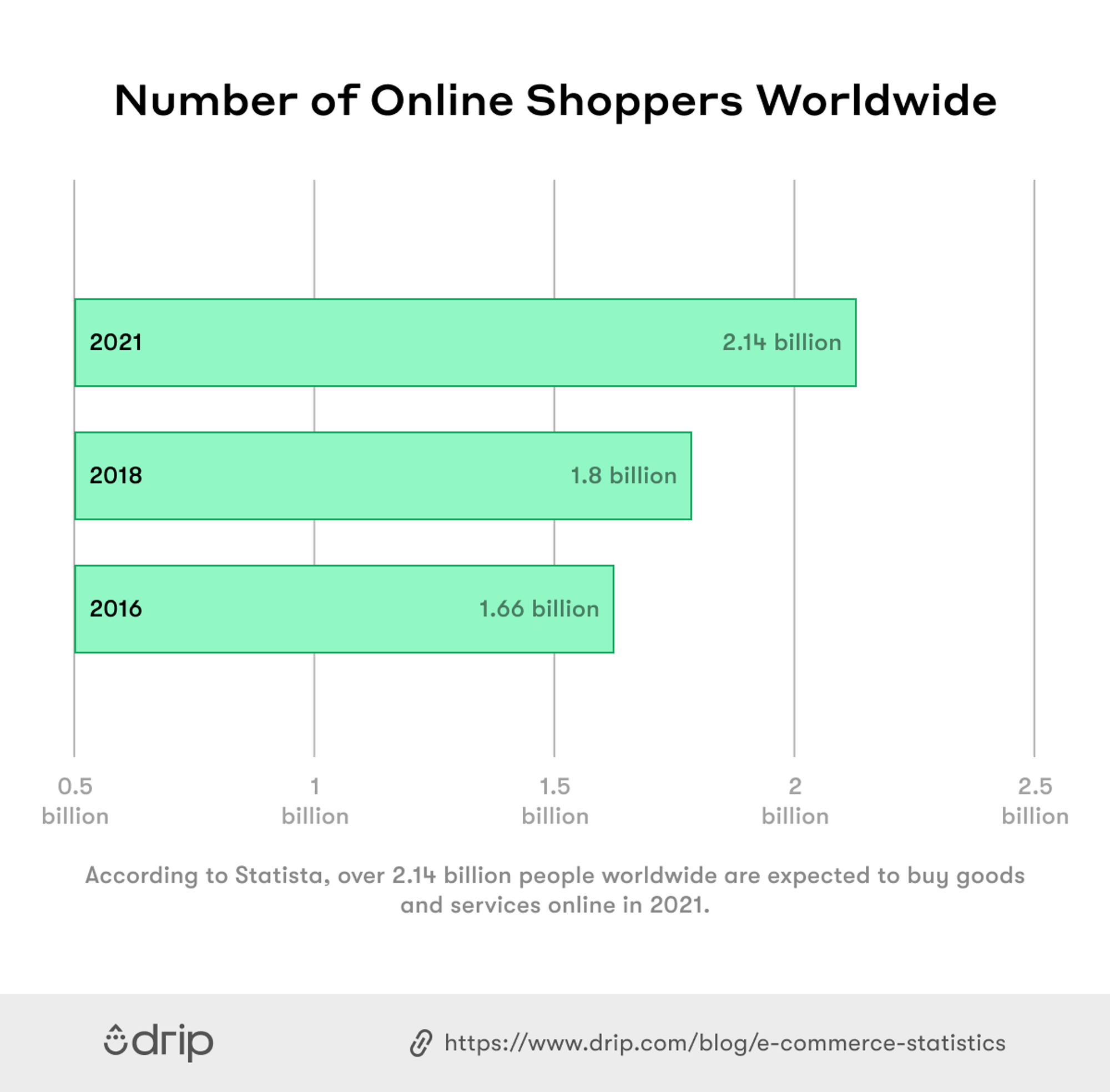
Considering that number increased from 1.66 billion in 2016, global ecommerce growth won’t stop anytime soon.
What do these numbers mean for you?
If you’re not already selling online, this should be your call to do so. And if you’re unsure how to get started, check out this article where Emil compares the most popular ecommerce platforms.
2. Ecommerce Statistic #2: Only 2.17 Percent of Ecommerce Visits Convert Into Purchases
Although the total number of potential digital buyers is increasing worldwide, the conversion rate from a visitor into a customer saw a slight decrease in the third quarter of 2020.
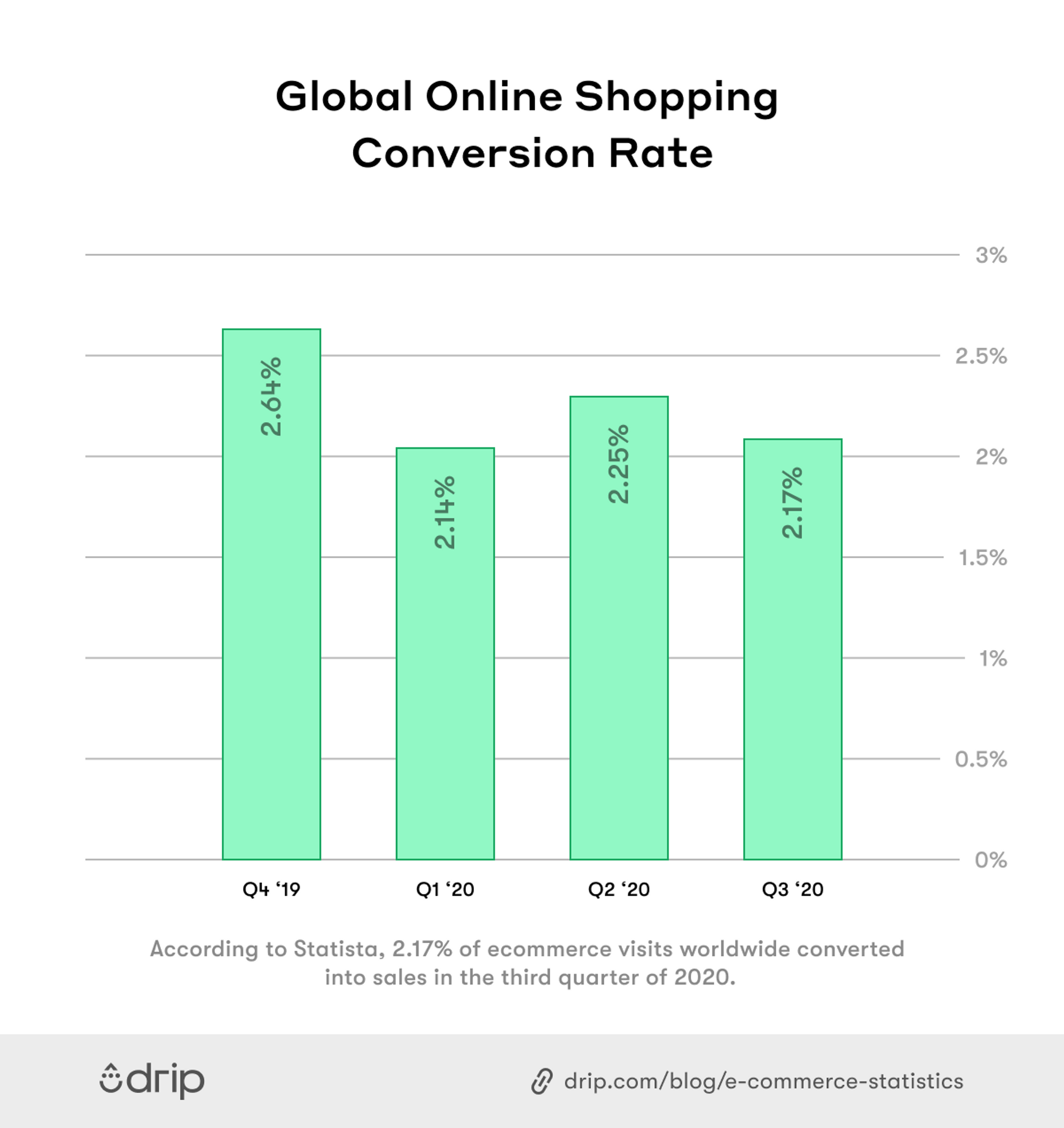
While this may sound like bad news, on the contrary, it means there are a lot of potential opportunities for you to uncover—provided you optimize your website for higher conversions.
If you only have time to improve one area of your ecommerce website, start from these 11 lesser-known tactics to optimize your product pages.
3. Ecommerce Statistic #3: Ecommerce Accounts For 18 Percent of All Retail Sales
The rapid growth of ecommerce doesn’t mean the end of the brick-and-mortar shopping experience. However, the competition between the two is getting more and more immense.
In 2020, ecommerce sales accounted for 18 percent of all retail sales worldwide.
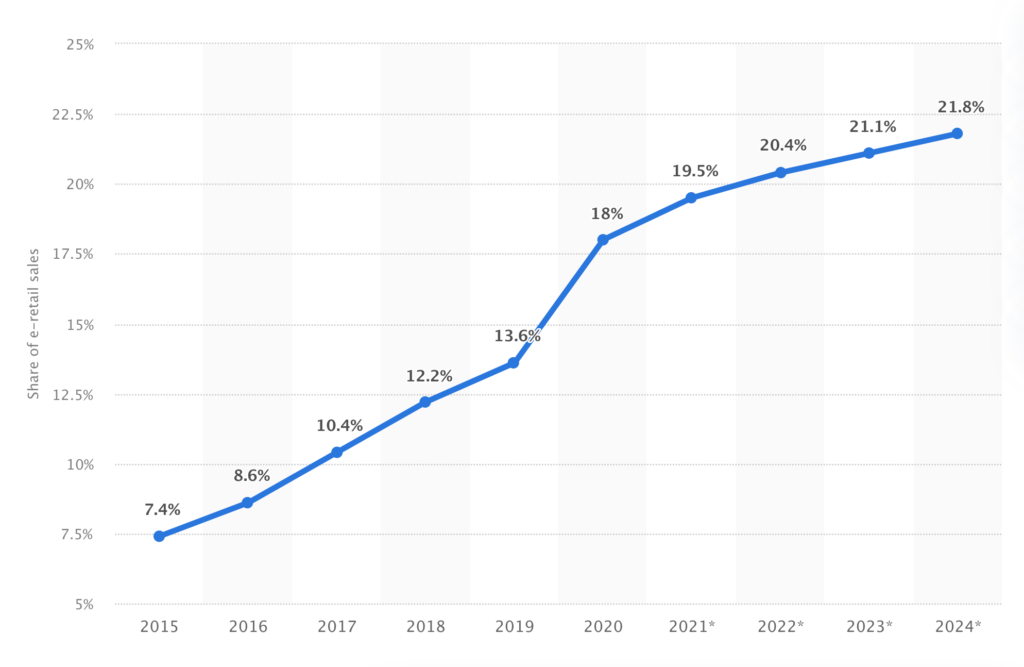
Source: Statista
Notice the big jump from 13.6 percent in 2019.
The projections for the future look especially bright for etailers. The share of ecommerce sales is expected to reach 19.5 percent by the end of this year, and 21.8 percent in 2024.
But there’s a downside to this.
With so many options to choose from, online shoppers only look for the most trustworthy ecommerce sites. By using trust badges on your site, you can showcase reliability, ease customers’ minds, and stand out among the competition.
4. Ecommerce Statistic #4: Amazon Is Expected to Account For 50 Percent of All Retail Sales in 2021
Amazon is a tough competitor to beat for e-tailers, especially in the US.
In 2017, Amazon’s market share in the US ecommerce retail space was 37 percent. But by the end of 2021, the ecommerce giant is estimated to account for half of all the retail sales in the States.
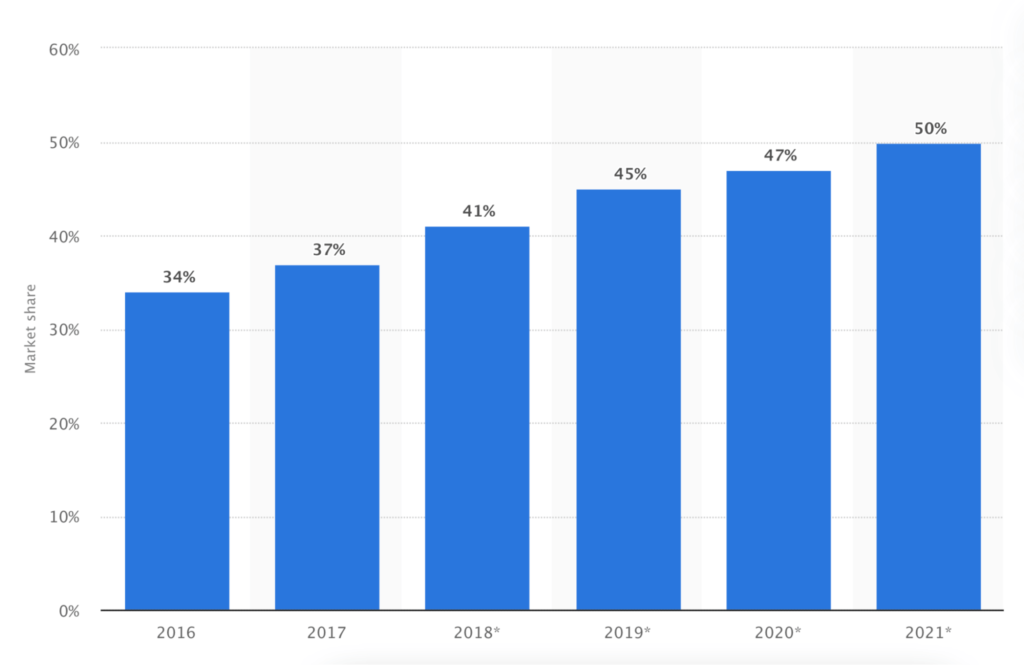
Source: Statista
If you’re already selling on Amazon, this may be good news for you. And if you’re not, make sure to optimize your ecommerce site for search, so you don’t lose valuable traffic to the ecommerce giant.
5. Ecommerce Statistic #5: E-Retail Sales Are Projected to Grow to $5.4 Trillion in 2022
It’s not only the number of online shoppers and the market share of ecommerce businesses that are constantly growing.
Etailers’ total revenue is also on the rise worldwide.
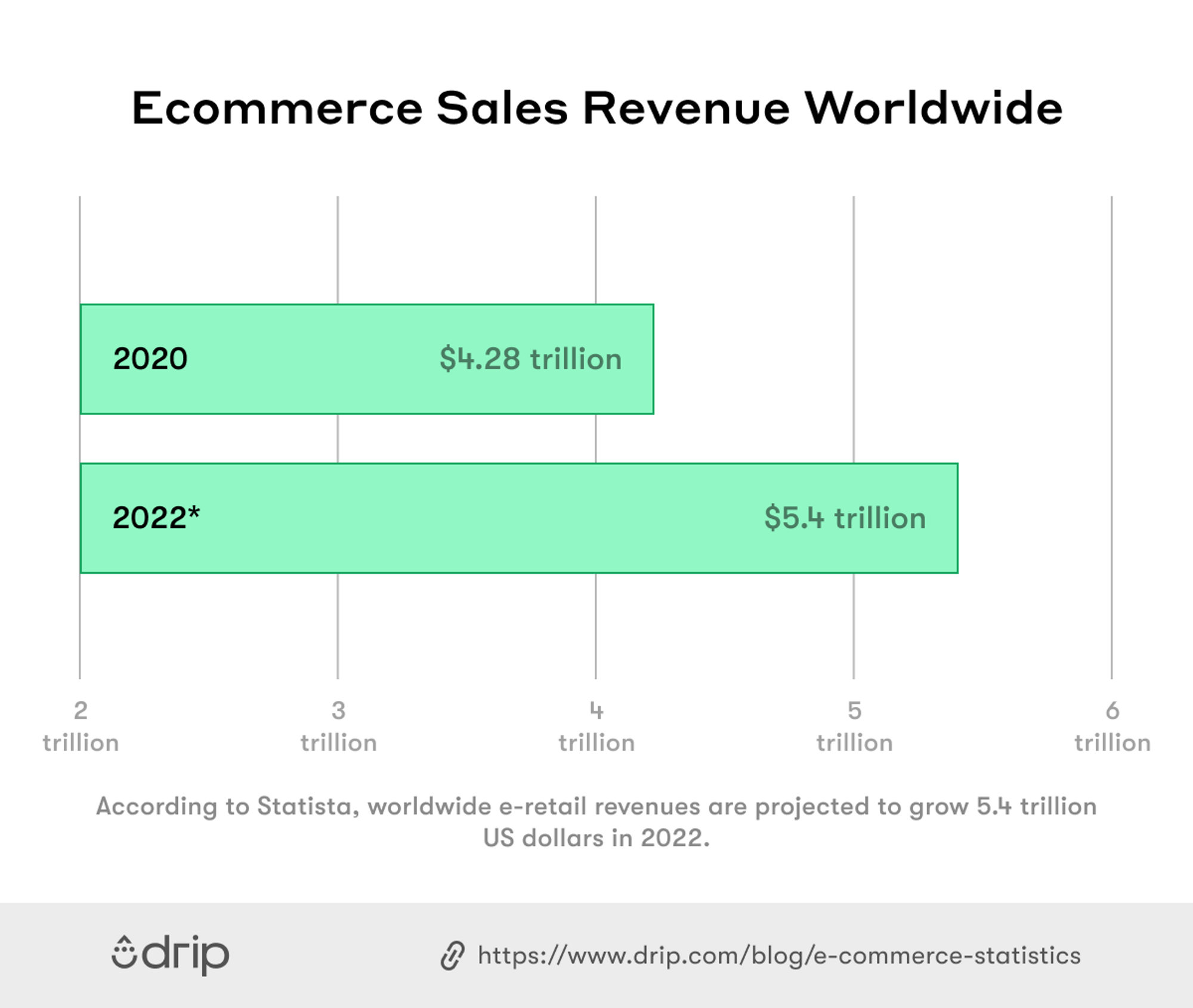
In 2017, global ecommerce sales brought around $4.28 trillion in revenue. What’s more, this figure is expected to rise to $5.4 trillion in 2022.
One foolproof way to increase online revenue is to upsell to customers at the perfect time and take them up to a higher price point.
For example, you can target customers with a relevant product recommendation popup during checkout to increase their average order value:

It’s a smart way to start taking your share from that $5.4 trillion even before 2022.
6. Ecommerce Statistic #6: 61 Percent of Online Retail Traffic Comes From Mobile
Mobile commerce is no longer an exception—it’s the norm.
With 61 percent of retail traffic coming from mobile devices, smartphones are now the preferred online shopping tool for most consumers.
But there’s a caveat.
Although mobile outperforms desktop in bringing website traffic, most online sales still take place on desktop.
In other words, most ecommerce sites are still not optimized for mobile when it comes to the final point of contact: checkout.
This article by Emil explains why and how you should optimize your mobile checkout for higher conversions and break this global pattern.
7. Ecommerce Statistic #7: 68 Percent of Online Shoppers Search a Product on Google Before Purchasing
Before you can optimize your website for a better shopping experience, you first need to understand the buyer’s journey.
Although no two visitors are alike, these recent stats show that there’s a shared pattern among online shoppers. And it’s that 68 percent of consumers turn to Google for information while they’re shopping for a specific product.
As the old adage goes, you need to be where your customers are.
In our case, you should be where your customers are searching for your products—Google shopping.
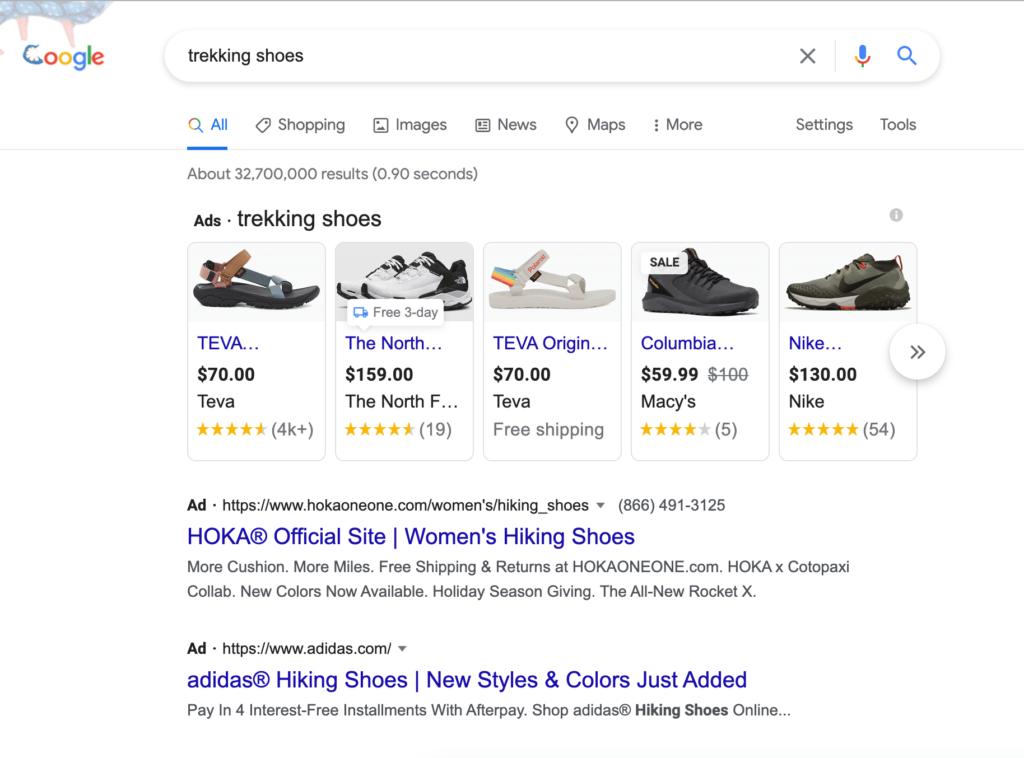
With Google shopping, you can promote your store to top-funnel prospects and offer a solution to the shopper’s problem at an early stage.
8. Ecommerce Statistic #8: Fashion Shoppers View 32 Pages Before Making a Purchase
Not all visitors convert into buyers in their first session. And even when they do, it often takes more than a few pageviews to get them to your checkout.
According to Statista, for apparel e-tailers, this number reaches an average of 32 pages in one session.
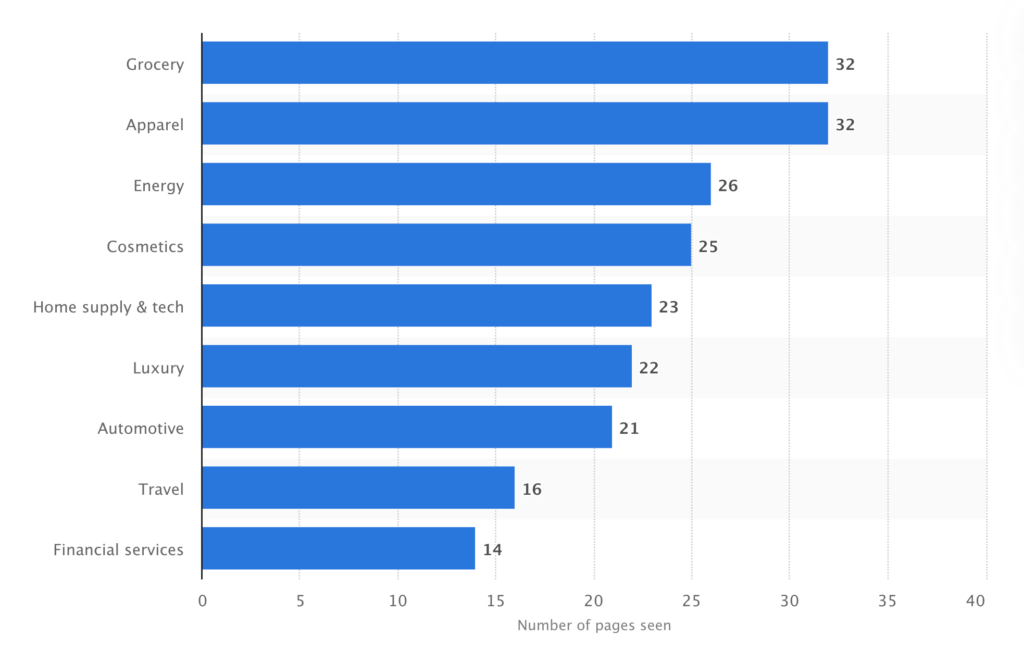
In other words, an average online buyer views 32 pages of a fashion ecommerce site in the same session they place an order. By contrast, this number is lower in industries with fewer product options, such as automotive and travel.
Put simply, fashion shoppers need better guidance on ecommerce sites, be it an offer for help or a gentle nudge to complete their purchase.

9. Ecommerce Statistic #9: Shoppers Value In-Stock Availability and Fast Delivery Most
Despite the ever-growing figures of success, not all ecommerce sites are created equal.
The intense competition and special measures taken in the midst of a global pandemic make it extra difficult for e-tailers to establish themselves as reliable sellers.
At these times, knowing what your potential customers value the most is the key to creating a pleasant experience for them.
In a recent study, 43 percent of online shoppers named (1) in-stock availability of desired items and (2) fast and reliable delivery as the two most important attributes when shopping online.
There are at least two action items here for ecommerce managers:
- Leverage out-of-stock notifications and email your subscribers when their desired items are back in stock; and
- Incentivize high-value orders with a free fast delivery option.
Prioritize these two strategies and you should see an increase in orders, without hurting your profit margins.
10. Ecommerce Statistic #10: 3D Product Images Increase Conversions by 250 Percent
The brick-and-mortar shopping experience is hard to replicate online. Buyers can’t get the touch and feel of the products they purchase online to the same extent as offline.
That’s why good product photography can be a decisive factor for buyers to choose your store over others, such as in this example from Away:
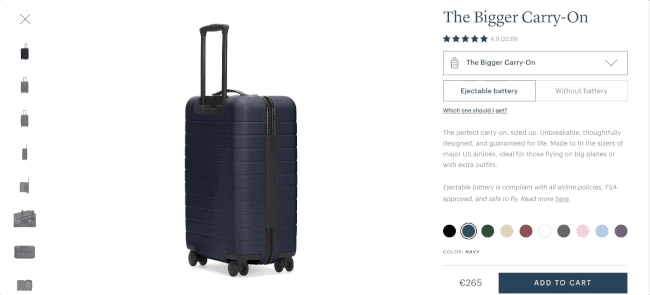
3D or 360-degree product images like the above make it easier for shoppers to visualize these items in action, and according to Shopify, they can increase conversions by up to 250 percent.
But what if you can’t afford to use augmented reality in your store?
Record videos that show your products from different angles.
You can even embed your videos into website popups and show them at the perfect time to visitors, such as when they click a button or during checkout.
11. Ecommerce Statistic #11: Digital and Mobile Wallets Account For 45 Percent of Ecommerce Payments
Online shopping is all about convenience. This means that the days of “accepting only major credit cards” are over.
A recent study found that digital and mobile wallets, such as PayPal, Apple Pay, and Google Pay, accounted for almost 45 percent of global ecommerce transactions in 2020.
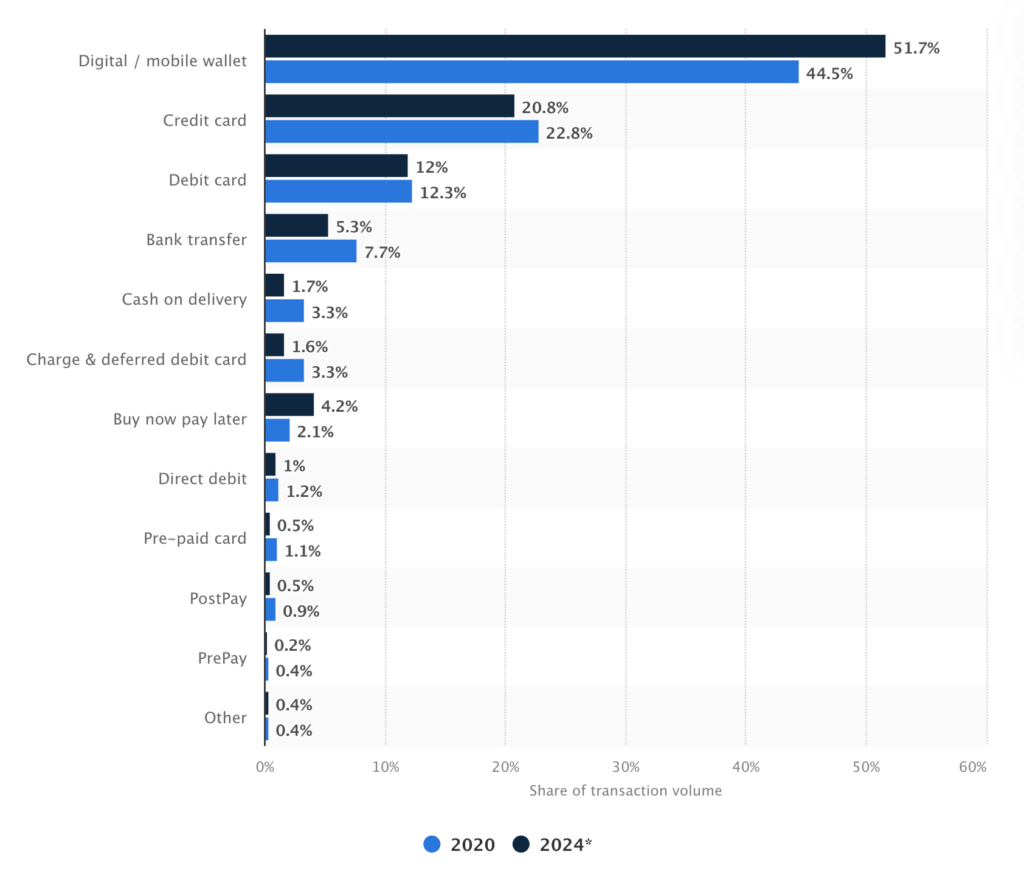
Source: Statista
What’s more, digital wallets are expected to increase their share in 2024 and reach up to 51.7 percent, by taking a big percentage off of traditional payment methods, such as credit cards, bank transfers, and cash on delivery.
However, digital wallets aren’t popular to the same extent everywhere in the world.
If, then, you’re targeting a global audience, make sure to offer shoppers more payment options.
12. Ecommerce Statistic #12: Popups in Ecommerce Convert at 4.76 Percent on Average
It’s not only ecommerce businesses that want to collect emails on their website. The same also goes for SaaS companies, travel agencies, automotive dealerships, and media outlets, to name a few other industries.
With that in mind, we took a deep dive into our customer data across several industries and found out that email popups convert better in ecommerce than any other industry.
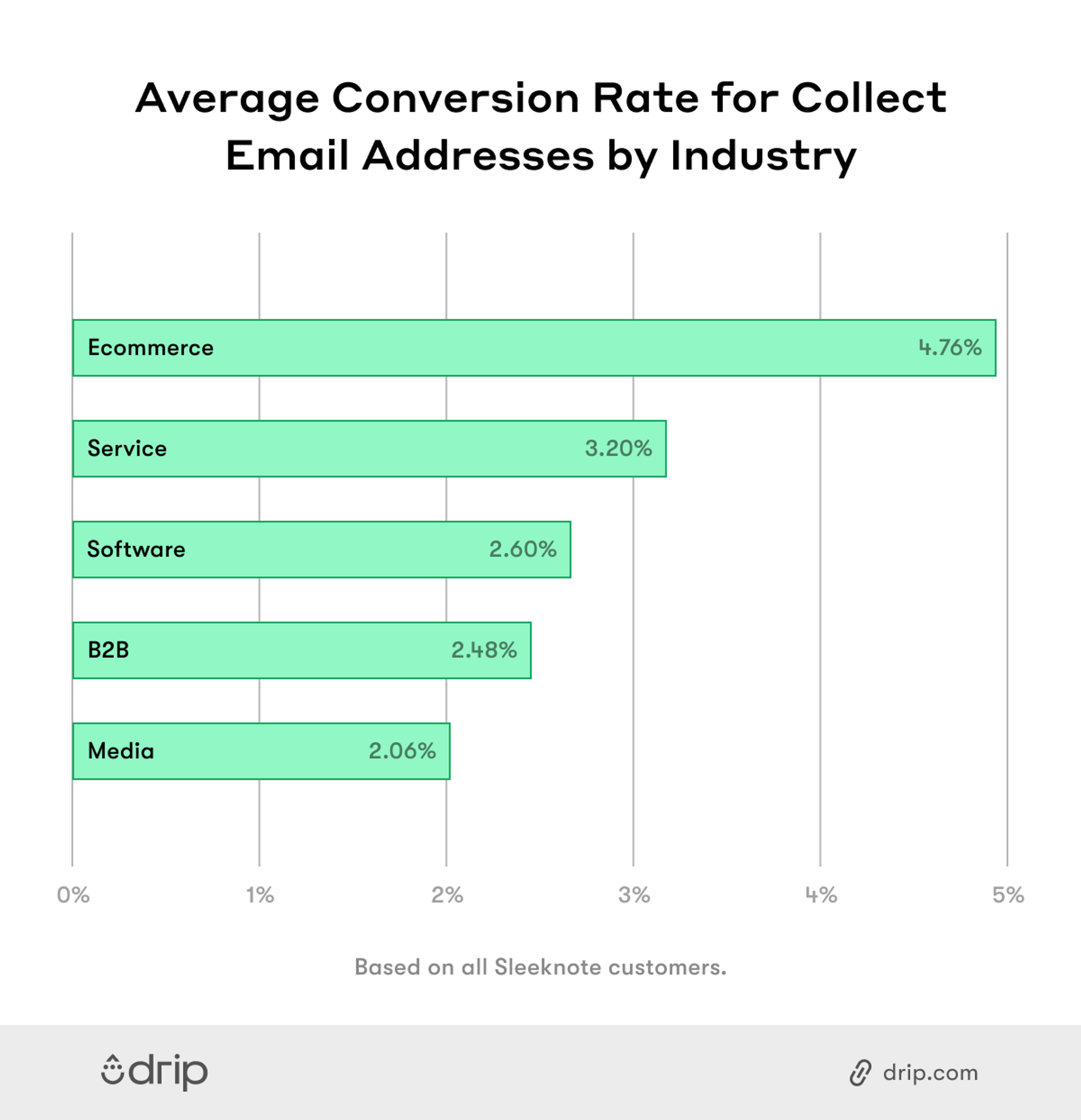
Ecommerce popups for collecting email addresses convert almost 5 percent of visitors into subscribers, followed by the service industry at 3.20 percent and SaaS popups with 2.60 percent.
What does this mean for your ecommerce business?
First, your visitors are used to popups. They might even expect to see popups, in one form or another, on your site to grab a deal in exchange for their email address.
So, if you’re in ecommerce and aren’t already using popups, start doing so. At least, create one to collect emails, and you’ll see the difference.
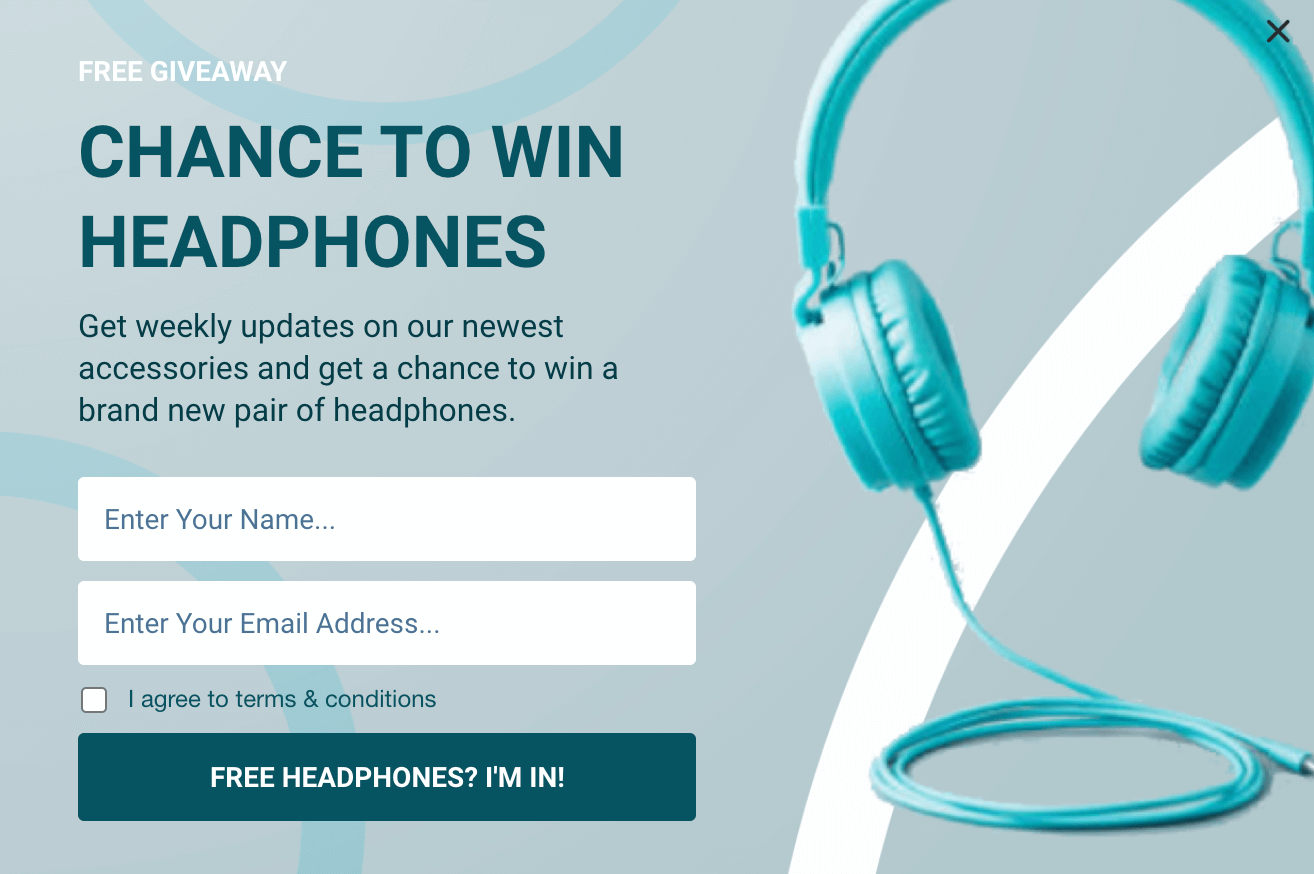
13. Ecommerce Statistic #13: Popups With Two Input Fields Outperform All Others
Not all email popups are the same.
Unclear copy, bad design, or poor timing can significantly hurt your email popup’s conversion rate.
Similarly, popups with too many input fields can scare visitors, making them leave your site.
Our data suggest that popups with two input fields convert the best, followed closely by popups with only one input field.
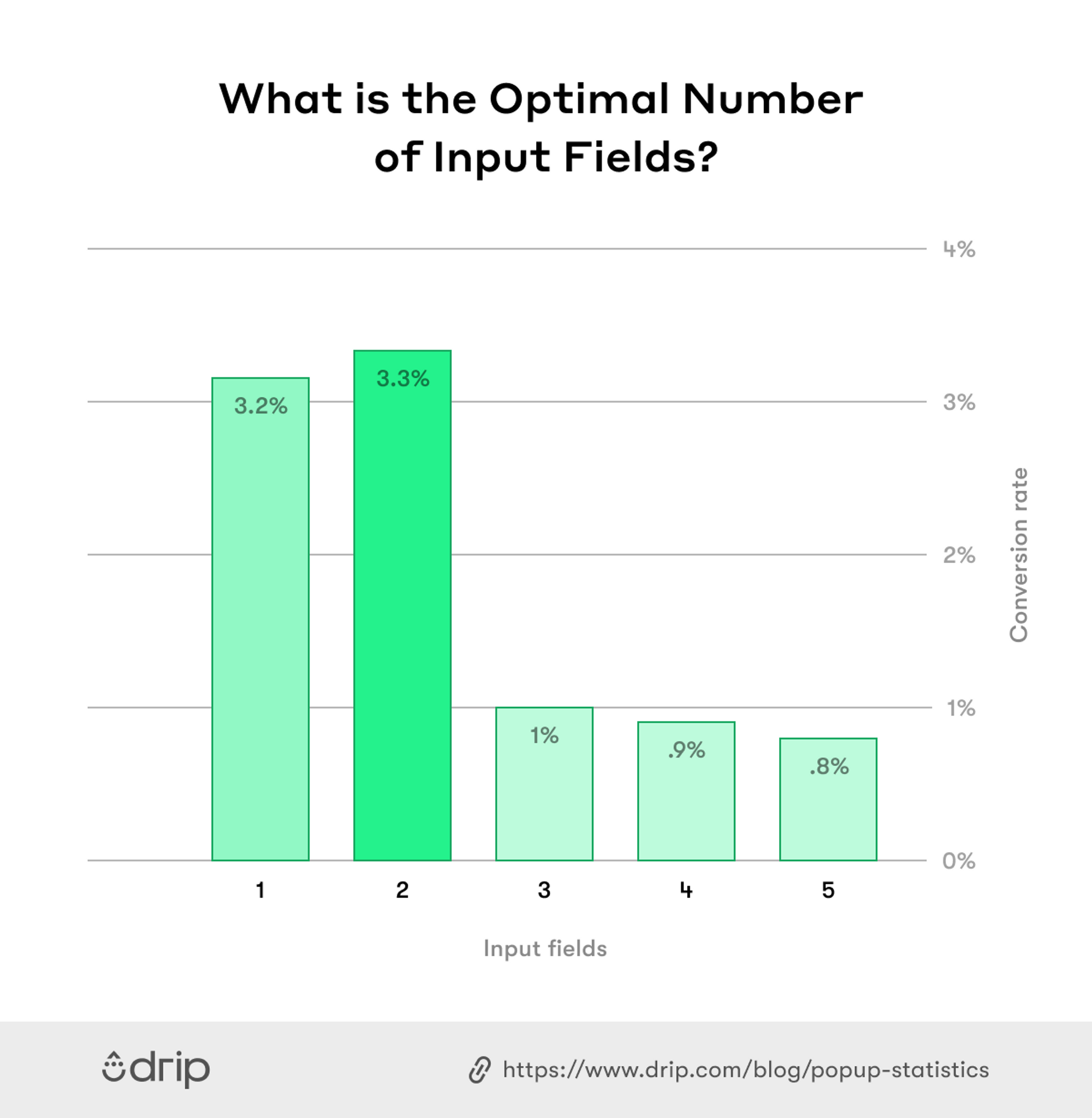 So, if you have an email popup asking five questions, consider limiting your input fields only to the essentials: email address and first name.
So, if you have an email popup asking five questions, consider limiting your input fields only to the essentials: email address and first name.And if you must ask those other three questions, create a multistep popup, and save those input fields for the second step.
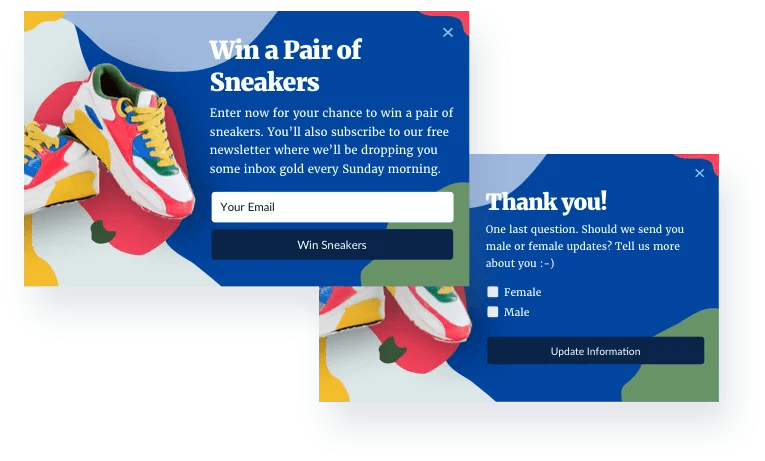
14. Ecommerce Statistic #14: Mobile Popups Convert at 5.8 Percent on Average
Although mobile devices are driving most of the online retail traffic in 2021, they’re still behind desktop in terms of sales (see Stat #6).
But how does mobile perform in bringing in new email subscribers?
That’s what we researched, and the results were surprising.
After analyzing our customers’ campaigns, we found that popups convert better on mobile (5.8 percent) than they do on desktop (3.11 percent).
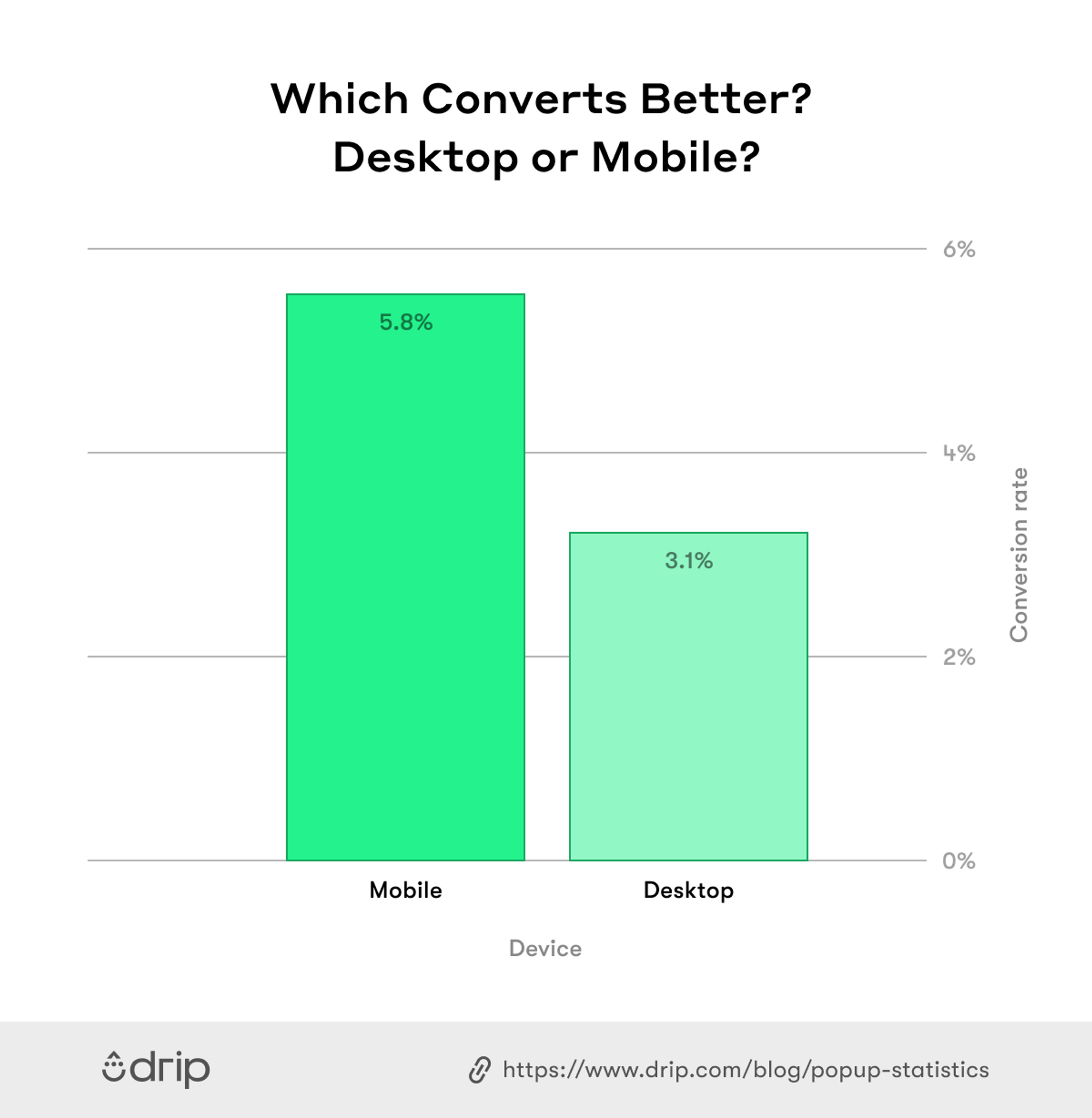 There are two main takeaways here for ecommerce marketers:
There are two main takeaways here for ecommerce marketers:- If you’re not using popups on your mobile website, start doing that today.
- If you already have mobile popups, optimize them for higher conversions by reducing font sizes, removing unnecessary images, and using a teaser.
15. Ecommerce Statistic #15: The Average Cart Abandonment Rate Is 69.80%
If there’s one ecommerce metric you need to pay close attention to month after month, it’s your shopping cart abandonment rate.
A higher than average cart abandonment rate should set off alarm bells as it might hint at a critical problem in your store.
According to Baymard Institute’s latest data, the average cart abandonment rate across industries is 69.89 percent.
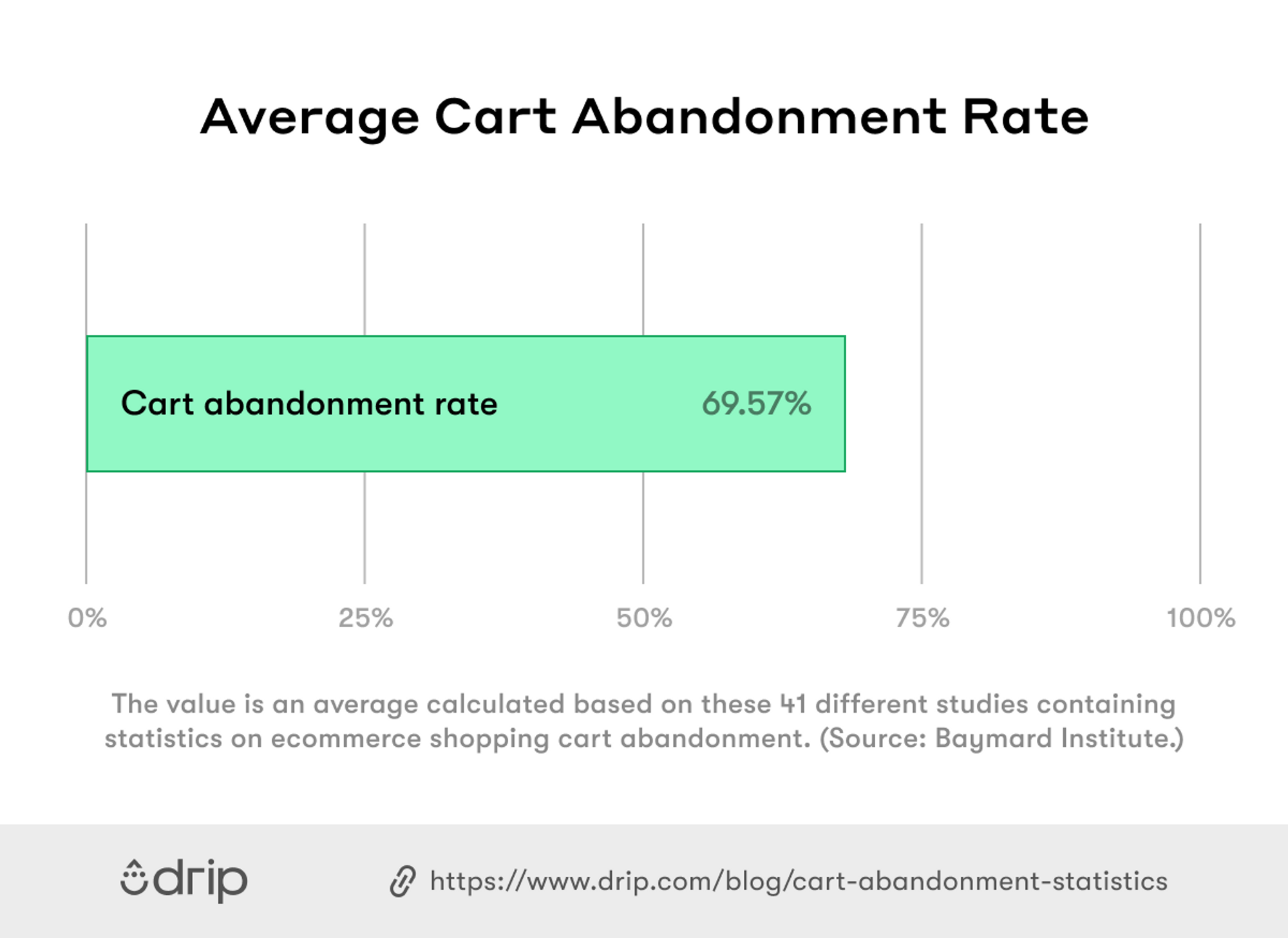
In other words, seven out of 10 shoppers leave their carts without completing their purchase.
This means lots of potential revenue you can recover with email marketing and website popups.
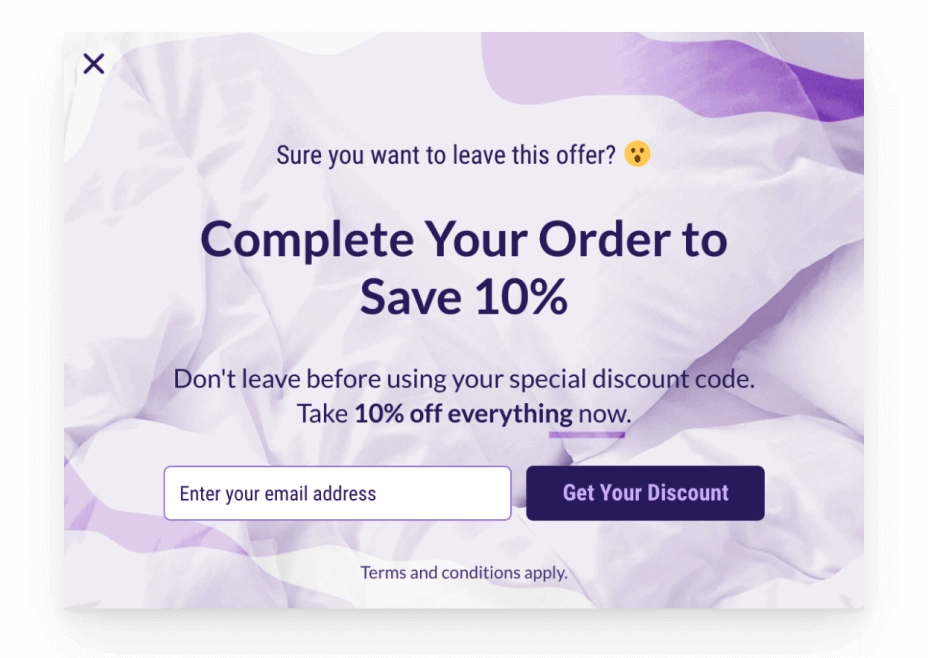
16. Ecommerce Statistic #16: 49 Percent of Shoppers Abandon Their Carts Because of Unexpected Extra Costs
Shipping, tax, additional fees—research suggests that unexpected extra costs like these can be a dealbreaker for many ecommerce visitors.
In fact, 49 percent of online shoppers abandon their baskets due to unexpected extra costs.
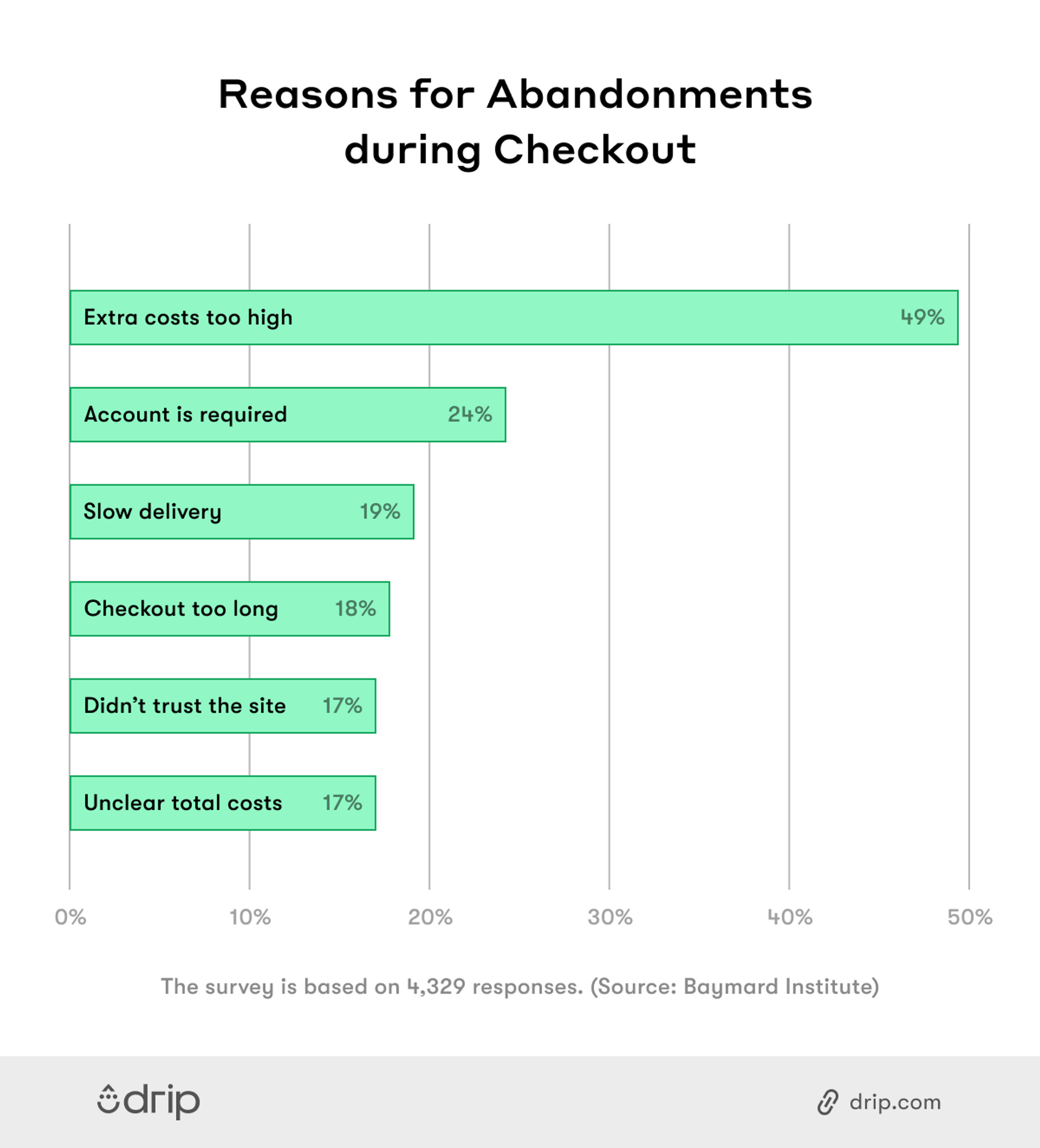
Other reasons why shoppers leave their carts include the requirement to create an account, slow delivery, long checkout processes, lack of trust, and confusion about total costs.
However, none of these even come close to the number one reason.
To ease customers’ minds and reduce cart abandonment, you need to be crystal clear about any costs associated with your orders.
If you’re offering free shipping and returns or a satisfaction guarantee, remind visitors of these benefits with a popup during checkout too:
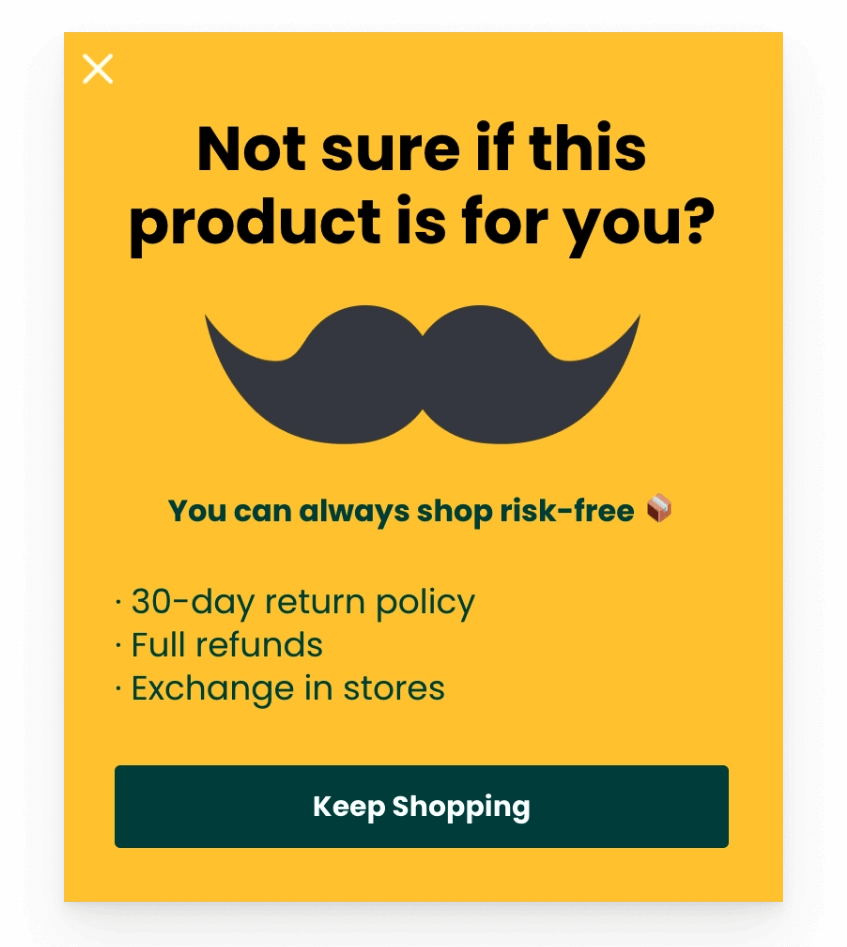
17. Ecommerce Statistic #17: Abandoned Cart Emails Have an Average Open Rate of 45 Percent
Now the good news.
Abandoned carts can be recovered with timely popups and well-written emails.
In fact, Moosend found that abandoned cart emails have an open rate of 45 percent on average.
Abandoned cart emails included in that study also had a 21 percent click-through rate and resulted in half of those clicks becoming purchases. Not bad for one email, huh?
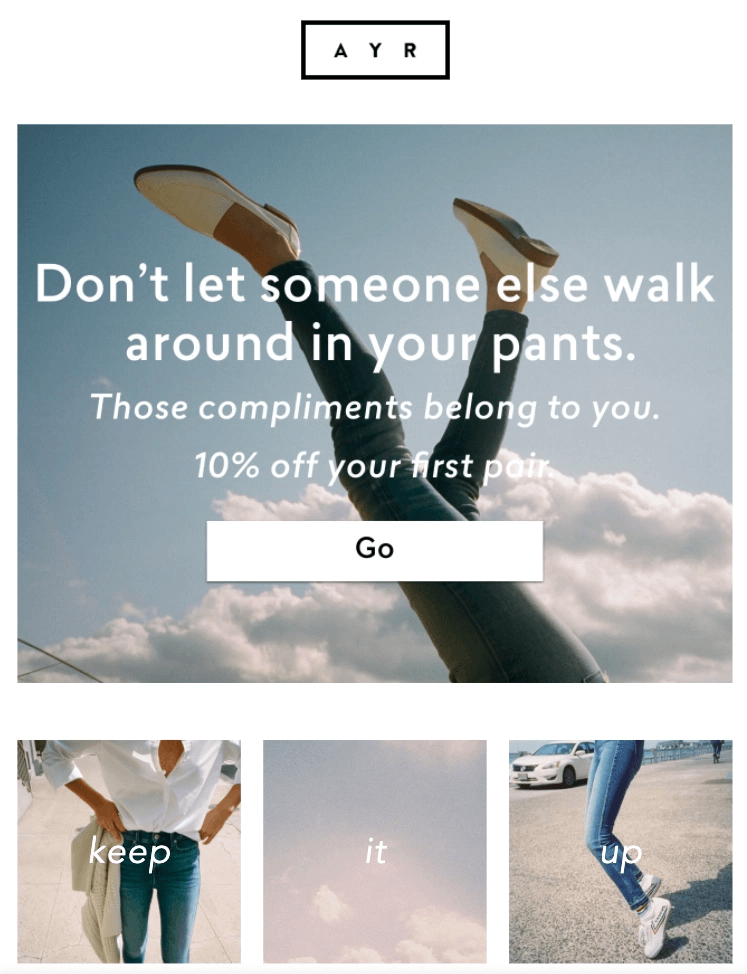
If you need inspiration for crafting high-converting abandoned cart emails, like the above, check out this post I wrote a while back.
18. Ecommerce Statistic #1: 8 Three-Quarters of Repeat Purchases Are Made Online
Customer retention is just as important in terms of acquisition for your revenue, if not more important.
After all, happy customers that know your brand tend to spend more and bring more referrals.
Where does ecommerce fit in this equation, then?
Recent stats show that three-quarters of repeat purchases take place online, whereas as many as 71 percent of consumers prefer to make first-time purchases at a physical store.
In other words, you should focus on sending engaging email campaigns to your list and encourage customers to buy from you—again and again.
If you want to go the extra mile, consider starting a customer loyalty program and give shoppers a compelling reason to return to your store.
19. Ecommerce Statistic #19: The Fastest-Growing Ecommerce Niches of 2020 Are Disposable Gloves and Bread Machines
The Covid19 outbreak, doubtlessly, changed the way we live, work, and interact with others.
But it also changed the way we shop and consume products.
Staying at home for longer periods and hygiene concerns naturally resulted in new niches growing rapidly.
According to Statista, the two fastest-growing ecommerce niches in 2020 have been disposable gloves and bread machines.
The former category saw an increase of 670 percent since March 2019, while the latter grew by 652 percent since the same date.
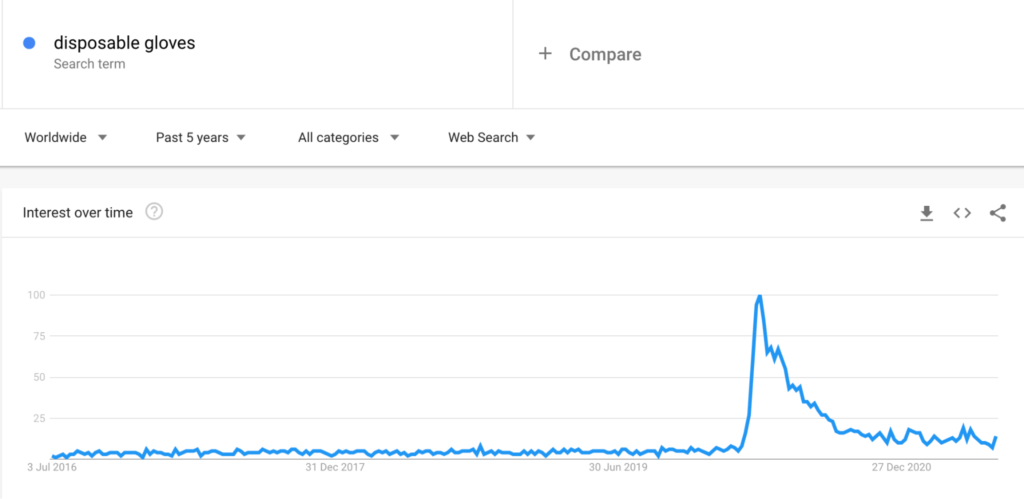
The bottom line here isn’t to start investing in these new categories, of course. It is to keep an eye on emerging niches with Google trends and promote your relevant products around your store.

Conclusion
Developing an efficient marketing strategy for your online store requires knowledge about ecommerce statistics, trends, and consumer habits.
I hope this article gave you the insight to help you get started on that strategy, and that you found some of the answers you were looking for.



